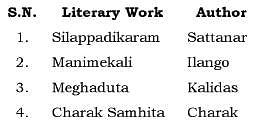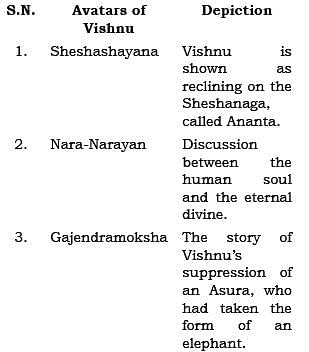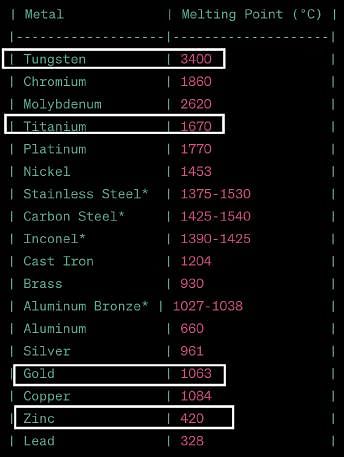UPSC CSE Complete Practice Test - 4 - UPSC MCQ
30 Questions MCQ Test - UPSC CSE Complete Practice Test - 4
The lowest amount of water in the soil that a plant requires to maintain its turgidity is known as:
Consider the following statements regarding Koraput Kala Jeera Rice.
- It is the black-coloured rice variety known for its aroma, texture and nutritional value.
- It is mainly grown in controlled environment with monitored sunlight and moisture.
- The rice grains resemble cumin seeds.
How many of the above statements is/are correct?
| 1 Crore+ students have signed up on EduRev. Have you? Download the App |
Consider the following statements regarding Square Kilometer Array.
- Square Kilometer Array is a single large telescope.
- Some of the SKA Square Kilometer Array facilities would be located in India.
- The intellectual properties generated by the project would be accessible to all the member countries.
How many of the above statements is/are correct?
The State of the World’s Forests Report is released by
Consider the following statements.
- India has decided to build a gravitational wave detector to join the international LIGO (Laser Interferometer Gravitational Wave Observatory) network.
- India is a full member of the ITER project, which is working to harness energy from nuclear fusion reactions.
- India has a strong participation in the Large Hadron Collider (LHC), the world’s largest and most powerful particle accelerator.
How many of the above statements is/are correct?
The Tarapore Committee constituted by the Reserve Bank of India, was
Consider the following statements regarding bases:
1. Bases often have a bitter taste.
2. Bases turn red litmus paper blue.
3. All bases are insouble in water.
How many of the statements given above are correct?
What is the primary application of electrochemical machining (ECM) in industry?
Arrange the melting points of the following metals in decreasing order:
1. Tungsten
2. Titanium
3. Gold
4. Zinc
Select the correct answer using the code given below.
Consider the following statements regarding a catalyst in chemical reactions:
1. A catalyst is a substance that gets completely consumed in a reaction and increases the rate of the reaction.
2. Platinum is commonly used as a catalyst in chemical reactions.
Which of the statements given above is/are correct?
In the context of astronomy, what is the phenomenon of gravitational lensing?
Consider the following statements with respect to viruses:
1. A virus cannot reproduce by itself and needs to enter an organism for its reproduction.
2. The genetic material inside the virus consists of RNA only.
3. A virus which infects and replicates within a bacteria is called a viroid.
4. The diseases of Herpes and Hepatitis are caused by viruses.
How many of the above statements are correct?
Which one of the following statements best describes the purpose of 'Site Directed Nuclease (SDN)'?
Consider the following statements with respect to plant physiology:
1. C3 plants are twice as efficient as C4 plants in terms of fixing carbon.
2. The direction of movement in the xylem is always unidirectional.
3. Mycorrhizae represent a symbiotic association of rhizobacteria and plant roots.
How many of the statements given above are correct?
Consider the following statements with reference to Project Cheetah:
1. Project Cheetah has led to translocation of 20 cheetahs from the countries of Sahel Region of Africa in Kuno National Park.
2. It has been implemented by National Tiger conservation authority.
Which of the statements given above is/are correct?
Consider the following pairs:

How many of the above pairs is/are correctly matched?
In ancient India, the term "Shamans" referred to
Consider the following statements:
1. The early Buddhist teachings had given great importance to self-effort in achieving Nibbana.
2. The supporters of Mahayana regarded other Buddhists as the followers of Hinayana.
3. The worship of the images of the Buddha and the Bodhisattas became an important part of the Mahayana tradition.
How many of the above statements is/are correct?
Consider the following statements with reference to the administration during the Mauryan period:
1. Pradeshta, Rajuka and Yukta were the officers at the district level.
2. Gopa and Sthanika acted as the intermediaries between the district and the village level administrative units.
Which of the statements given above is/are correct?
With reference to ancient India, consider the following statements:
1. The Sudarshan Lake was constructed during the reign of the Saka ruler Rudradaman.
2. An inscription written in Pali has described about the lake.
3. The lake was once repaired during the period of the Gupta rulers.
How many of the above statements is/are correct?
With reference to ancient India, which of the following were the contemporary towns of Pataliputra during the period of the Mahaj anapadas?
1. Shravasti
2. Ujjayani
3. Puhar
4. Bagh
5. Shishupalgarh
How many of the cities given above is/are the contemporary towns of Pataliputra?
Witl^ reference to the ancient Indian history, consider the following statements:
1. Kodumanal town of Tamil Nadu was well known for bead-making industry.
2. Tortoise shells, sapphires, silk cloth and diamonds were exported from the Malabar coast.
3. Major trade between India and the Roman empire was through the Persian Gulf.
How many of the above statements is/are correct?
Consider the following statements:
1. The inscription at Mandagapattu mentions Rajendra I with numerous titles, such as Vichitrachitta and Chitrakarapuli.
2. The Tirumalaipuram caves and the Jaina caves at Sittanvasal were patronized by the Pandyas.
3. The temple of Darasuram in Tamil Nadu was built during the reign of Rajaraja Chola.
How many of the above statements is/are correct?
Consider the following statements:
1. The Lakshmana temple of Khajuraho is dedicated to Shiva.
2. The temples at Khajuraho are primarily of the Buddhist origin.
Which of the statements given above is/are correct?
Consider the following pairs:

How many of the above pairs is/are correctly matched?
Consider the following statements regarding the Sun temple at Modhera:
1. It was built by Raja Bhimdev I of the Chalukya dynasty.
2. Surya Kund is a massive rectangular stepped tank located at the front of the temple.
3. At the time of the summer solstice, the Sun shines directly into the central shrine of the temple.
How many of the above statements is/are correct?
With reference to the Kamakhya temple of Assam, consider the following statements:
1. It is built at the Nilachal hills in Guwahati and is famous for the Tantric practices.
2. It is the centre of the Kulachara Tantra Marga and the site of the Ambubachi Mela.
Which of the statements given above is/are correct?
“It is one of the greatest and most beautiful bazaars, called Tarababad and the marketplace for male and female singers. The shops are decorated with carpets and at the centre of the shop there is a swing on which sits the female singer. In the middle of the marketplace, there stands a large cupola, which is carpeted and decorated and in which the chief of the musicians takes his place every Thursday after the dawn prayers, accompanied by his servants and slaves.” The above statements reflect the features of the market of which one of the following cities of medieval India?
With reference to medieval India, Uluq and Dawa were well-known as
With reference to an excerpt from Francois Bernier’s description of the landownership, consider the following statements:
1. According to him, one of the fundamental differences between Mughal India and Europe was the lack of private property in land in the former.
2. He was a firm believer in the virtues of private property and saw crown ownership of land as being harmful to both the state and its people.
Which of the statements given above is/are correct?



















